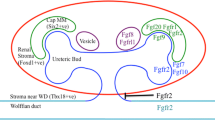Abstract
Systemic treatment with epidermal growth factor (EGF) induces growth of all wall layers of the urinary tract in pigs and rats. In this study, we describe the time-dependent growth of the ureter and bladder. Forty-eight female Wistar rats were allocated into five groups receiving EGF treatment (150 μg/kg per day) for 0 (controls), 1, 2, 3 or 4 weeks before being killed. The 24-h urine excretion was increased only in the group treated for 4 weeks with EGF. Measured by a simple infusion device, EGF significantly increased the bladder capacity by more than 50% in all the EGF-treated groups. The volumes of the wall layers of the ureter and bladder were quantified using stereology. After 4 weeks of treatment with EGF, the total volumes of the ureter and bladder were 1.8- and 2.1-fold larger than in the control group (the urothelium was 2.8- and 3.5-fold larger and the muscular coat 1.6- and 1.6-fold larger in the ureter and bladder, respectively). In conclusion, the EGF-induced growth of the urinary tract is characterized by increased bladder capacity, and increased volume of all wall layers – most prominently the urothelium.
Similar content being viewed by others
Author information
Authors and Affiliations
Additional information
Received: 5 February 1997 / Accepted: 29 October 1997
Rights and permissions
About this article
Cite this article
Vinter-Jensen, L., Nielsen, K. The effects of exogenous epidermal growth factor on the developing urinary tract in rats: a stereological description. Urological Research 26, 105–110 (1998). https://doi.org/10.1007/s002400050031
Issue Date:
DOI: https://doi.org/10.1007/s002400050031




